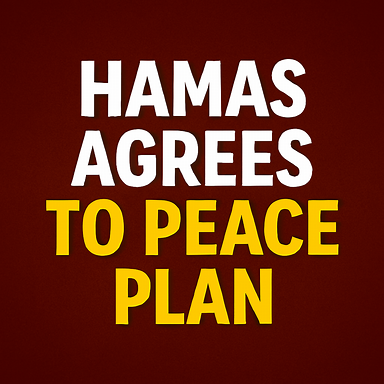After nearly two years of war and months of difficult diplomacy, Hamas has publicly signalled that it accepts significant elements of a U.S.-backed plan to end the Gaza conflict — including a commitment to release the remaining Israeli hostages and to hand Gaza’s civilian administration over to a non-Hamas, technocratic Palestinian authority.

That acceptance is partial and conditional: major issues such as disarmament, sequencing, verification and long-term governance remain unresolved and will determine whether the breakthrough holds.
What Hamas has said it will accept
- Release of Israeli hostages (alive and deceased) — Hamas has reportedly agreed, in its formal response to the U.S. proposal, to release all remaining hostages held in Gaza under the exchange formula set out by the plan. This concession is the single most politically urgent element for Israel and for many international mediators.
- Handing administration to a technocratic Palestinian body — Hamas has indicated it will step back from day-to-day governance in favour of a Palestinian technocratic administration — described by supporters of the plan as non-political and internationally supervised — as part of a broader political transition in Gaza. The precise legal and practical details of that handover are not yet agreed.
- Willingness to enter negotiations on timing and implementation — Hamas’s response was explicitly conditional: it accepts certain points in principle and has passed that response to mediators (including Qatar, Egypt, and the United States), signalling readiness to participate in technical talks about sequencing, logistics and verification.
What Hamas has not accepted (or remains ambiguous)
- Full disarmament: The plan’s demand that militant groups in Gaza be disarmed — a red line for Israel and a stated objective for Washington — has not been fully accepted by Hamas. Hamas leaders and political cadres have not publicly committed to giving up arms, and negotiators say this remains the toughest, most contentious issue.
- Clear, immediate Israeli withdrawal and end to military operations: While Hamas has signalled it would accept an “initial withdrawal line” as part of the exchange framework, it has insisted that releases occur under safe, verifiable conditions. Israel has said it will adhere to an “initial withdrawal line” only if conditions for its security are met; disagreements over how fast and how complete any pullback should be persist.
- Sequencing and verification safeguards: Hamas wants assurances about the sequencing (which side makes what concession first), humanitarian access, and independent mechanisms to verify compliance. Israel and the U.S. are insisting on strict verification; exactly which international actors will monitor and enforce terms remains a matter for the mediators.
The plan in outline (why it matters)
The U.S. proposal — publicly championed by President Donald Trump and outlined in detail by the White House — ties a rapid hostage release to an initial halt in large-scale fighting and the withdrawal of Israeli forces to a predefined line inside Gaza, followed by further steps to stabilize the territory: a technocratic Palestinian administration, massive humanitarian relief and reconstruction, and a pathway toward longer-term political arrangements. As currently described, the plan also calls for the dismantling of Hamas’s military infrastructure as a longer-term objective. The plan’s backbone is a phased approach in which hostage releases and prisoner exchanges are the immediate bilateral objectives that could buy breathing space for a political transition.





0 Comments